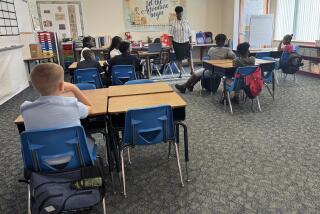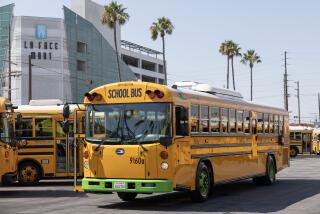In Florida, Limit Class Size Now, Pay Later
PEMBROKE PINES, Fla. — Welcome to Charles W. Flanagan High School, Florida’s biggest. The prize-winning marching band, at 240 members, is so large it must rehearse in four separate sections. Between periods, say Flanagan students, bathrooms are often too crowded to use.
Designed for 2,835 children, the school, in one of Florida’s fastest-growing municipalities, now has more than 5,300, and faculty members are feeling the strain. Social sciences teacher Oscar Siflinger has one class of 60 students. If he assigns an essay, grading the papers might consume an entire evening.
“The class size is destroying us,” Siflinger said. “I don’t believe in mass production. We need to make these students think.”
The most far-reaching decision by voters in Florida this month might not have been the reelection of Jeb Bush, a first for a Republican governor here, but approval of an amendment to the state’s Constitution that will cap the size of classes in the public schools.
The amendment establishes statewide ceilings, to be in place by 2010, of 18 students in kindergarten through third grade, 22 in fourth through eighth grades and 25 in high school. According to Kathy Christie, vice president for knowledge management at the Denver-based Education Commission of the States, at least 20 states, including California, have adopted laws to fix or recommend limits on class sizes, but Florida is the first to make a cap mandatory under its Constitution.
“This is probably the most ambitious measure we’ve seen,” Christie said.
Constructing the thousands of extra classrooms required for smaller classes, and finding new teachers to teach in them and ways to pay for all this, is the biggest headache now facing the leaders of the Sunshine State. Bush, who campaigned hard, and ultimately to no avail, against the amendment, once warned that the expenses it carries, combined with other fiscal challenges for Florida, “would blot out the sun.”
In an unguarded moment, Bush also told one campaign audience he had “devious plans” to subvert the class-size measure if voters approved it. The president’s brother later said he regretted the remark, and now speaks of the need to craft a “flexible” approach for implementation.
Estimates for how much it will cost to bring Florida’s public schools into conformity during the eight-year phase-in period range from $8 billion to $27.5 billion.
According to one calculation, 29,000 new classrooms may be needed. In 2003-04 alone, according to a report from the state Senate, Florida will need to recruit almost 25,000 more teachers, in large part because of shrinking class size.
This means colossal new expenditures, at a time when government revenues have been dwindling because of the economic slowdown.
Lobbyists for gambling interests have offered themselves as Florida’s financial angels, claiming that if permission is granted them to place video gambling machines at dog and horse tracks and jai alai frontons, new tax revenue could reach $1 billion.
“I don’t have a plan yet,” Bush said after the election. The governor has said he opposes extending gambling, cutting social services or imposing a tax increase, but that he has a constitutional duty to comply with the amendment.
Voters, who approved the measure by a 52% to 48% margin, didn’t seem to lose any sleep over how to finance it, said Ken Wald, a professor of political science at the University of Florida.
“People in Florida want lots of services but don’t want to pay for them,” Wald said. “We want representation without taxation.”
If Floridians are so blithe, they may not be alone. In 1996, the California Legislature adopted a law providing funding incentives for smaller classes in kindergarten through third grade, but evidently did not consider all the consequences. About 20,000 new teachers were needed, and certification requirements had to be relaxed to fill the new jobs.
In some school districts, there were concerns about the qualifications of the new hires, as well as a shortage of substitute teachers. Some schools in low-income areas, meanwhile, reported an exodus of experienced fourth- and fifth-grade teachers seeking positions in smaller kindergarten-to-third-grade classes in more affluent districts.
What did motivate voters, supporters of the classroom cap believe, is the crowding that has become chronic in Florida’s schools as population growth outpaces the ability, or willingness, of elected officials to provide services.
“Every major county in the state has school overcrowding and class-size problems,” said Democratic state Sen. Debbie Wasserman Schultz, co-chair of the pro-amendment Coalition to Reduce Class Size, and whose district includes Pembroke Pines. “You have a generation of kids being shuffled and pushed and pulled, and forced into a learning environment where it is very difficult for them to succeed.”
To finance the building and staffing of new classrooms, Democrats want to review $24 billion in annual exemptions from the state sales tax -- including stadium sky boxes, lawyers’ fees and escort services -- and $4 billion in tax reductions under Bush they claim went mostly went to the state’s wealthiest residents.
At Flanagan High, which opened seven years ago, classes now average nearly 35 students, or as many as 10 children above the new legal limit. Twenty-eight trailer-like “portable classrooms” already sit on concrete blocks outside the main two-story, dusty-pink building to handle the burgeoning student body, and the 1,900 ninth-graders have been spun off to a satellite location.
As she showed a visitor around, Principal Sharton Hill Shaulis stopped to hear a part of the school band, the Falcon Sound, rehearse a march from Rimsky-Korsakov, and a chorus, the Madrigals, sing a number from “A Chorus Line.”
“Now, if all these classrooms are already full, where are we going to put the new classes?” she wondered aloud.
In the bustling lunchroom, teacher Brian Flaherty keeps order as students chow down in three shifts. “We’re at critical mass,” he said.
Some of the pressure is supposed to be taken off Shaulis and her 335-member staff by the opening of a new high school in this area inland from Fort Lauderdale next year. It’s a belated reaction by the Broward County School Board to growth in Pembroke Pines, whose population began soaring when people fled the devastation wrought by Hurricane Andrew to the south a decade ago.
“It’ll be so nice to have only 3,000 students,” said Shaulis, 52, who confides that when she thinks she has it tough, she flips on an episode of “Boston Public.” For now, the halls at Flanagan are so thronged between classes she has banned the use of lockers, which she said slow down students, make them tardy and sometimes cause fights.
For many educators nationwide, Florida voters have taken an important step to better assure the quality of learning given their children.
“I’ve had small, medium and large classes, and I can tell you that small class size definitely allowed me as a teacher to spend more time with young people and give them more individualized attention,” said Reg Weaver, a middle-school teacher from Harvey, Ill., who is now president of the National Education Assn., a teachers union with 2.7 million members nationwide. “You can give better direction, in the event you need such. When you have a classroom that is orderly, it makes it conducive to discipline and learning. Long-term, smaller class size also helps reduce dropout rates.”
However, studies of the effects of class size have led to more nuanced conclusions. According to Christie, whose organization’s mission is to work with state officials to improve education policy, a study in Tennessee did indicate smaller class size is important to children in the lower grades. However, as the age of pupils rises, it appears to become less influential on what and how they learn.
For older children, “there is no unanimity about the educational value,” Christie said. “Money may be better spent elsewhere.”
At Flanagan High, the changes will come too late for seniors like Megan King, 17, editor-in-chief of the school newspaper, the Raptor. For them, overcrowding will be one of their lasting teenage memories, along with the Falcons’ exploits on the football field and this month’s Homecoming dance.
“Walking through the hallways is insane; it’s impossible to get through all the people,” King said. “The student parking lot has 500 spaces, and there are 1,200 seniors. One of my classes, Algebra 2, has like 40 kids in it. That’s annoying, because you don’t have as much individual help.”
More to Read
Sign up for Essential California
The most important California stories and recommendations in your inbox every morning.
You may occasionally receive promotional content from the Los Angeles Times.










